Another Lend-Lease. LVT-4. The Buffalo, son of an Alligator
Those who happen to see the expositions of foreign museums, the best of all American, will be surprised by another name of this car - Amtrak. The name, according to American tradition, as we have repeatedly pointed out, comes from the combination of two words. Amphibious (floating) tractor. Am plus Track (eng. Tractor).
Attentive readers have already noticed that the presented machine was produced in series. If there is an 4 version, then there were at least previous 3. It really is. And the story of the 4-th LVT is impossible without a story, albeit superficially, about the first machines in this series.
In general, amphibious vehicles are vital for the US Army. The structure of the Armed Forces itself is created so that the Navy in it has a fairly large weight. Marines for Americans priority type of troops. And the Marine Corps is generally independent as our Airborne Forces and has a lot of things in its composition.
It was on the order of the US Navy in the middle of the 30-ies engineer D. Roebling created the first military floating conveyors. This model was developed in 1938-41's. And in 1941, it was launched into mass production. So - LVT-1.
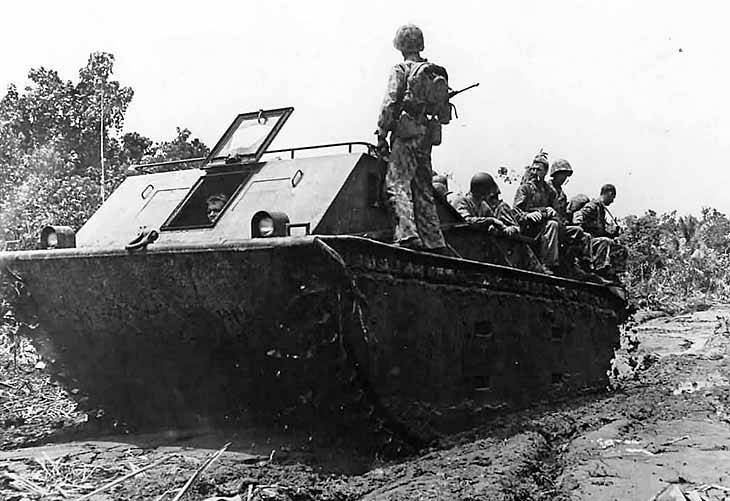
The first floating model tank According to the photo, Roebling’s banner, namely, was located on board the first production car, the ROEBLING AMPHIBIAN TANK, launched in the summer of 1941. It was immediately received with a bang by the military.
The initial contract for the production of LVT-1 provided for the release of all 200 machines. But, literally a few days after the start of the series, the contract was extended to 1225 machines. And the “tank” itself received a bloodthirsty nickname “Alligator”.
540 transporters received the Marine Corps, 485-transferred to the US Army. The remaining vehicles were sent for viewing in the Allied army.
Drew attention to the "jumps" of the authors in the title - "tank carrier"? It would seem that what is easier to stick to the name that the author gave to his brainchild. We are trying to give an objective picture of the car. And there from the "tank" only the letter "T", and then in the wrong interpretation of the abbreviation.
The English name officially sounds like this - Landing Vehicle Tracked. And there was an "Alligator" unarmored floating tracked transporter.
The machine had a trough-shaped body, whose width was equal to almost half the length. The corps was divided into three compartments. Represent this classic "trough"? You can argue about the car endlessly. but try to argue on carrying capacity. Especially afloat.
The department of management had the form of a cabin, shifted as far forward as possible, rising above the water and equipped with a roof. It housed the commander of the car, a driver and an assistant driver. There were three observation windows in the front view of the cabin.
Another window (flap) was in the vertical sides, which in general gave the crew a good overview. On the machines of the first series, the front windows were spaced apart, later they were performed closer to each other.
Directly behind the department of control, there was an open-airborne detachment (it was also a cargo compartment), which contained 20 soldiers in full gear or about 2 tons of cargo.
In the rear part there was a closed engine compartment, where the 6-cylinder carburetor engine “Hercules” WXLC-3 hp 146 hp was installed. On the sides of the engine were fuel tanks with a total capacity of 303 l, which provided a power reserve of up to 121 km by land or to 80,5 km by water.
Hollow welded pontoons fastened to the sides of the hull, increasing the buoyancy and stability of the machine. Each pontoon was divided inside into five sections, and when one of them was broken through, the machine maintained a reserve of buoyancy and stability. The pontoons served as a frame for mounting parts and components of the chassis.
The drive wheel was mounted on the hull near the stern, and the guide wheel was mounted in the front upper corner of the pontoon. The mount of the guide wheel had a hydraulic mechanism for adjusting the tension of the track.
Track width - 260 mm. High pressed lugs, which served afloat with paddle-blades, obliquely fastened to the tracks. Rotation, both afloat and on land, was carried out by braking the single-track caterpillar.
The welded hull was assembled from sheets of soft (non-armored) steel of different thicknesses, since the LVT-1 was not considered as a combat (“assault”) amphibious assault vehicle, but only as a conveyor that allows you to quickly deliver soldiers or cargo from the ship directly to the coast.
To suppress possible enemy fire and self-defense from a close attack, they decided to arm the machine with one 12,7-mm machine gun М2НВ and one 7,62-mm М1919, or two machine guns М1919. By the way, at installation of machine guns the rail guide already known to our readers was used. What, in fact, reinvent the wheel?
In some machines, you can see other weapons. Sometimes it is the "technical creativity" of local gunsmiths, but more often it is the factory execution of requests for specific parts or even specific units.
We paid so much attention to the "Alligator" because, despite the relatively small release of these machines, they revealed some of the shortcomings and problems of solutions made by engineer Robbling.
First of all, the traditional for the time, the disadvantage - the engine. In those modes in which the Alligator had to work, the engine often simply collapsed. Strength left to wish, as they say.
But the biggest problem was the caterpillars. The rejection of the water propulsion in favor of the caterpillars, along with the positive aspects, has a number of significant drawbacks.
First of all, the heterogeneity of the environment of use and its aggressiveness in almost all moments. Sea water corrodes the metal is not worse than acid. This applies especially to the hinges.
Then - access to the sand. There is no need to comment. Here the blades were added to the hinges. In short, the option of swimming with the use of caterpillars is quite difficult to implement.
Even the usual ground for "floating" tracks is deadly. And for repairmen - a constant headache with the replacement of new ones.
Those shortcomings that we noticed, noticed and designers. Therefore, by December the new car was basically ready. The Japanese, by attacking Pearl Harbor, speeded up the adoption of the Water Buffalo - LVT-2. Buffalo car called the American soldiers.
Transporter was significantly different from the "Alligator". In fact, the LVT-2 is a completely different machine.
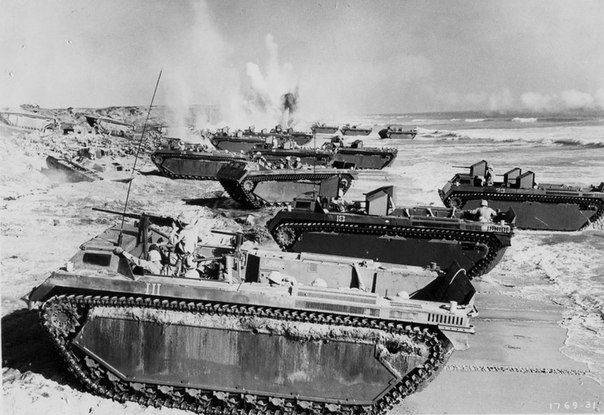
The hull had more "marine" contours. This not only improved the seaworthiness of the conveyor, but, no matter how strange it might sound, it greatly facilitated the car’s access to the shore.
The control compartment shifted back, the car received an elongated “nose” with a large inclination of the sheets. The hull was welded from steel sheets, a lattice frame welded to the bottom, and the main units were mounted on it. The nose part was strengthened by a tubular beam with brackets for cables.
The car turned out to be longer and wider than the previous one; the control room was lower; it had two large inspection hatches in the front sheet with forward-folding plexiglass windows (so that in critical situations the hatches could be used as manholes) and small inspection hatches in the cheekbones.
But most importantly, the car received the chassis and the engine of the tank!
The LVT-2 installed the engine and transmission of a light tank MZA1 "Stuart". In the engine compartment, fenced off from the landing by a partition, a star-shaped radial carburetor four-stroke engine "Continental" W-670-9 air-cooled power was mounted. 250 hp at 2400 rpm
The chassis has received an individual suspension with rubber elastic elements, called Torsilastic. All 11 track rollers were suspended from the hull side pontoons on the rocking arms, while the 1 and 11 rollers were raised above the ground, taking the load when coming out of the water to the shore and overcoming vertical obstacles, as well as providing tension on the track chains.
The specific pressure of all in 0,6 kg / cm2 allowed the car to go to the sandy shore, to move on loose sand, mud, swamp - LVT often passed where other transport vehicles were stuck. The length of the supporting surface was 3,21 m, and the gauge width was 2,88 m. Their ratio around 1,1 allowed the machine to turn on land with a radius equal to its length, running the tracks in opposite directions.
Engine power density compared with LVT-1 increased from 14,7 to 18 hp / t, payload increased to 2,7 - 2,9 t, a possible landing - to 24 fully equipped fighters.
Since the landing and disembarkation could be made only over the side, in the side sheets of the pontoons four ledges were made. From above the running gear was covered with eaves.
Along the perimeter, the hull had brackets for fixing the machine on the deck of a transport vessel, they were also used for securing cargo in the troop compartment.
The machine was armed with one 12,7-mm machine gun М2НВ and two or three 7,62-mm М1919А4, which were mounted on mobile units М35 with a swivel, moving along a rail guide along the perimeter of the troop compartment.
All these beauties were released 2 962. 1 355 vehicles took the Marine Corps, 1 507 - the US Army and the entire 100 units received by the allies. Knowing the fastidiousness of the US military, it becomes clear the quality of these machines.
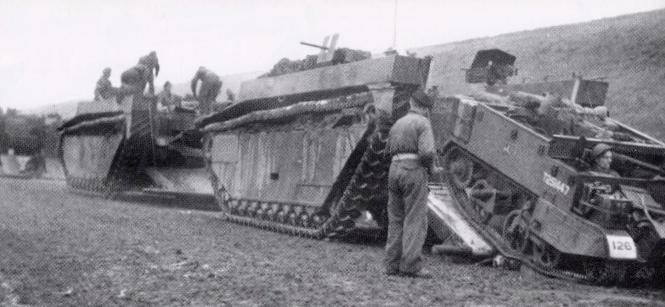
By the way, these are the machines we see in some photos with the 37-mm cannon taken from the Air Cobra (P-39 fighter). Launchers for NURSs were installed on the same machines. Mine trawls and other engineering equipment were installed on the same machines.
There is a nuance. The design of the car had one small but unpleasant flaw. The driveshaft passed through the middle of the troop compartment and prevented it from having serious armament there.
Marines and those who by the nature of their service were associated with frequent crossings, from among the readers, are already gladly rubbing their hands in anticipation of snide comments. In vain the authors so praise this car. The buffalo, he is the buffalo. power is - mind is not necessary.
When landing from ships, or when crossing water barriers, the conveyor must have a quality that Water Buffalo does not have. Namely, loading and unloading not only through the board, but also through special doors or ramps in the car. And for convenience in battle, the ramp should be in the stern!
Opened and forward. Fast loading and unloading of personnel, cargo, weapons. After all, the Marines have to act under heavy enemy fire, where every second of delay means death. Americans know it better than us.
In short, the main drawback of the "Alligator" and "Water Buffalo" was laid in the design solution itself. This is ... engine compartment. More precisely, its location. The aft arrangement of the engine compartment deprives the car of just the ramp.
The designers of the body actively pressed on the "motorists". It is necessary to move the engine forward. In this case, the body will have its own folding ramp. And that means the ability to boot the machine directly from the ground.
It is this machine that we see today at the Museum of military equipment of the UMMC in Upper Pyshma. And it passes under the symbol LVT-4.
LVT-4 created on the basis of LVT-2, but with the location of the engine compartment directly behind the department of management. In the roof of the new engine compartment executed blinds. The troop compartment shifted back, and instead of its rear wall, a folding ramp was installed, controlled by a manual winch.
Ramp winch added the car more than a ton of weight. But the amphibian could carry in its more spacious (due to the elimination of the propeller shaft) troop compartment on 1135 kg more cargo, and the possible length of the latter increased by 0,6 m.
The new model has preserved the elements of the hull structure, engine, transmission units, suspension, LVT-2 tracks.
With a payload of up to 4, the transporter could transport up to 30 fully equipped fighters, as well as light vehicles (say a jeep "Willis") or field guns.
In the troop compartment, for example, it was possible to place an 105-mm howitzer М2А1 with the wheels removed, and with some devices, the assembled howitzer could be mounted on the body from above.
To facilitate the loading of cars and tools on the inner side of the ramp there were ribbed tracks. The control room cabin was equipped with two observation windows in the front plate and inspection hatches in the cheekbones. Compared with the LVT-2, the sides of the machine are higher.
This transporter began to arrive in the army in 1944 year. Total produced 8 351 LVT-4, which amounted to slightly less than half of all issued LVT. More than 6 000 of them received the US Army, a little more 1 700 - Marine Corps, another 5 00 transferred to the lend-lease allies.
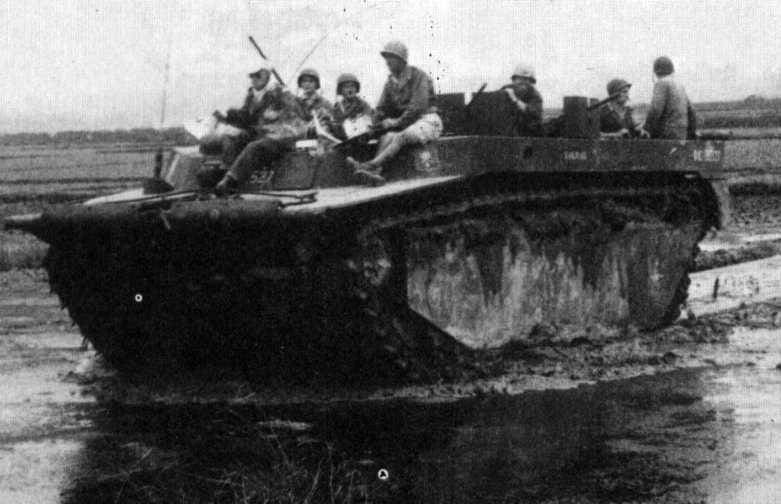
Several dozen such transporters got into our army. But none of them was used for its intended purpose. The vehicles were attached to intelligence units and acted as tractors. That, in principle, is understandable.
A machine designed for the Marine Corps and perfectly adapted to the amphibious landing force, in field conditions, loses many of its advantages. Like a duck among hens. It seems to go, not even behind others. But from the side of looking, it becomes clear - the duck must swim!
TTX LVT-4
Combat weight: 18,144 kg;
Length: 7975,6 mm;
Width: 3251,2 mm;
Height (with anti-aircraft machine gun): 3111,5 mm;
The volume of internal fuel tanks: 530 l (140 gallons);
Power reserve: 241 km;
Maximum speed on the water: 11 km / h (7 mph);
Maximum ground speed: 24 km / h;
Turning radius: 9,144 m (30 feet).
Engine: Continental W670-9A, carburetor aviationair cooling;
Engine displacement: 10,95 L (668 cubic inches);
Engine power: HP 250 at 2400 rpm
Armament: 12,7-mm M2HB machine gun and 7,62-mm machine gun.
Landing on board: up to 30 people. or up to 4 tons of cargo.
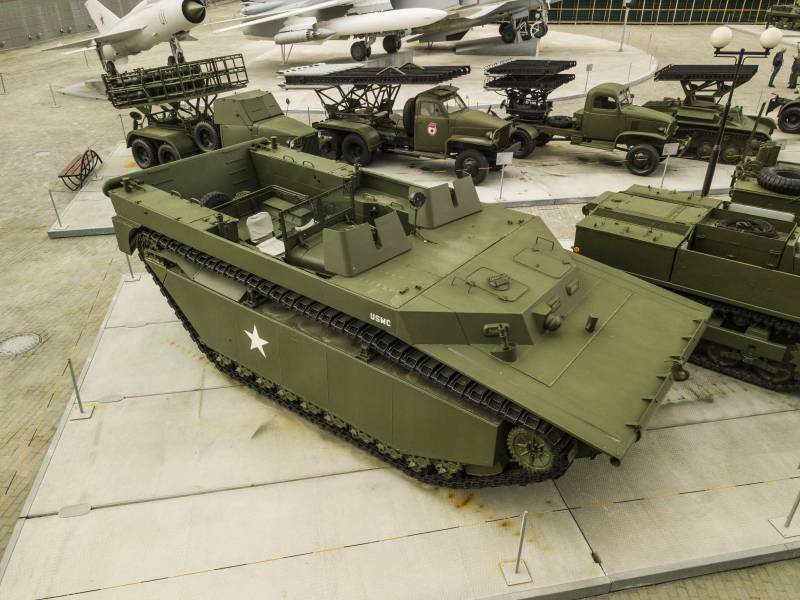
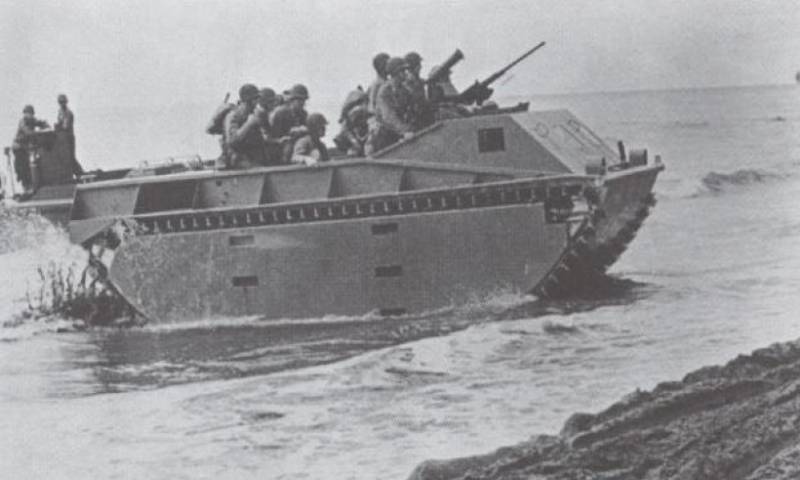
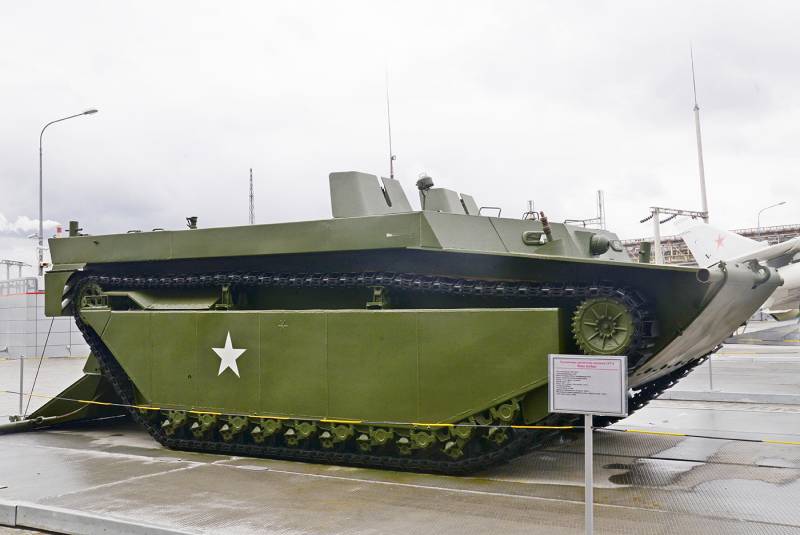
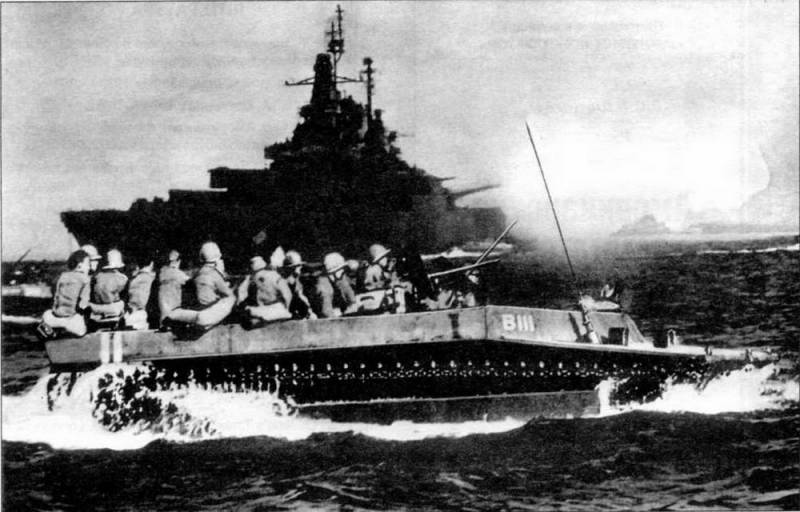
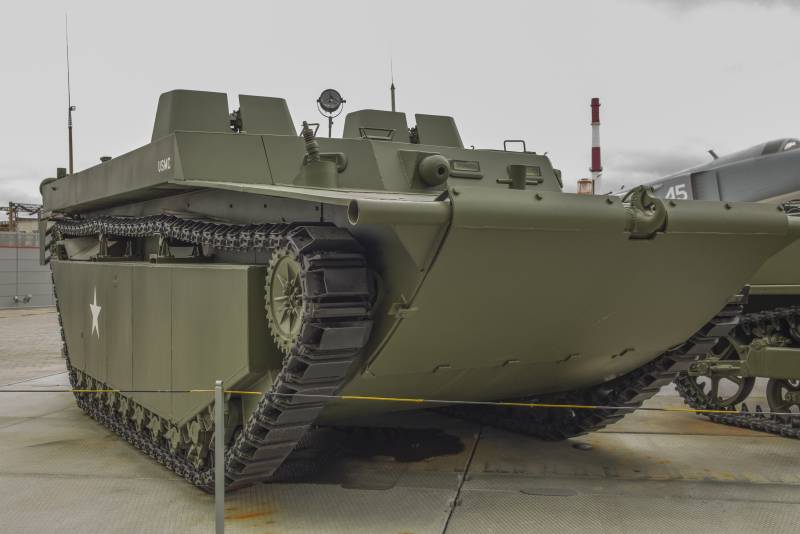
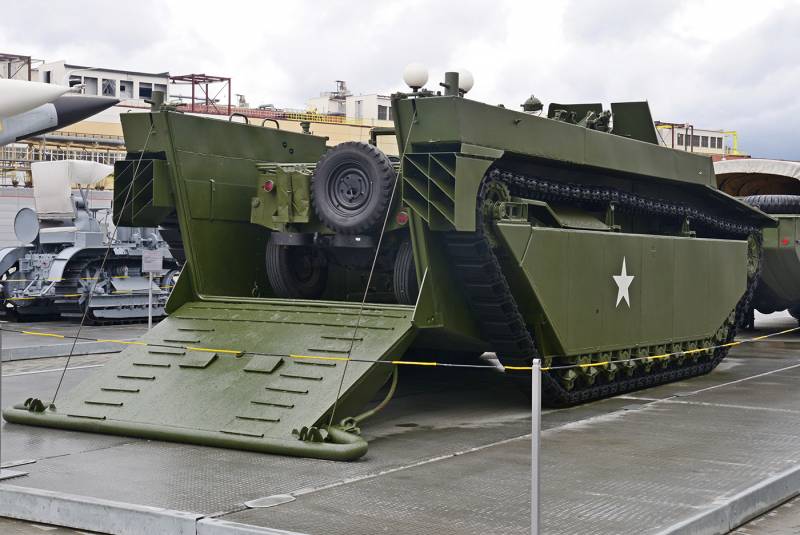
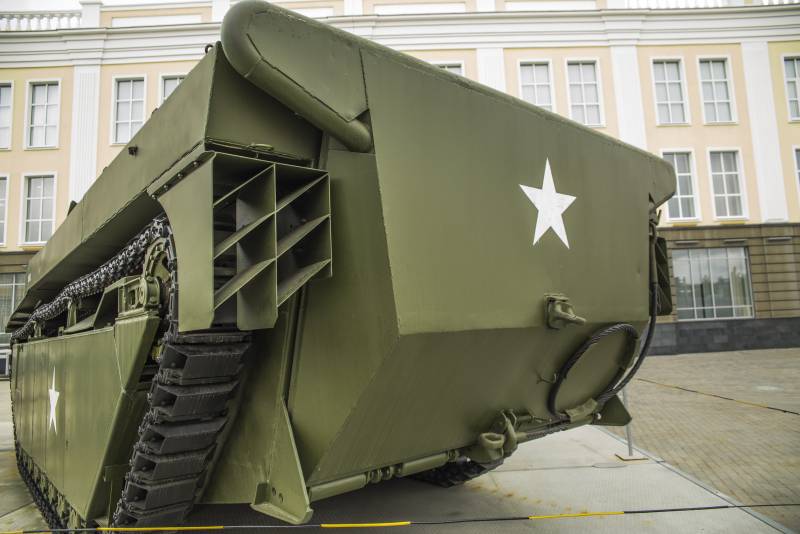
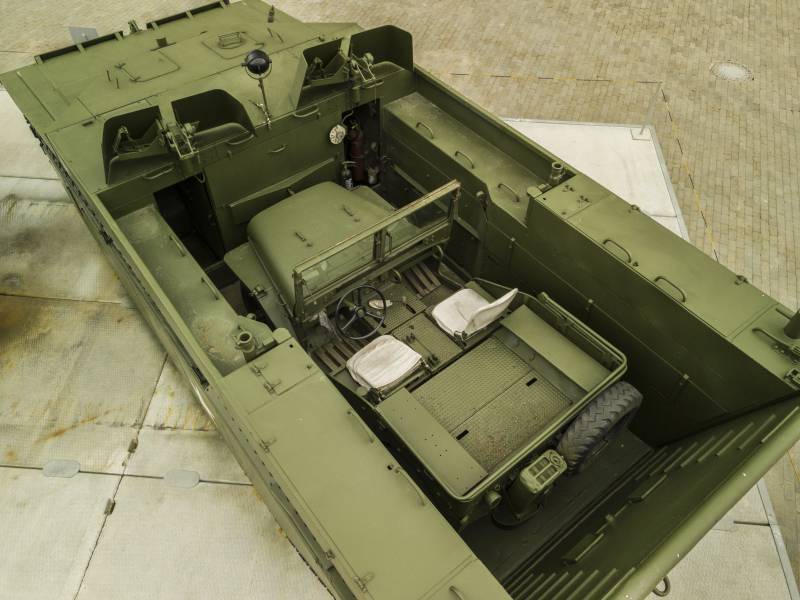
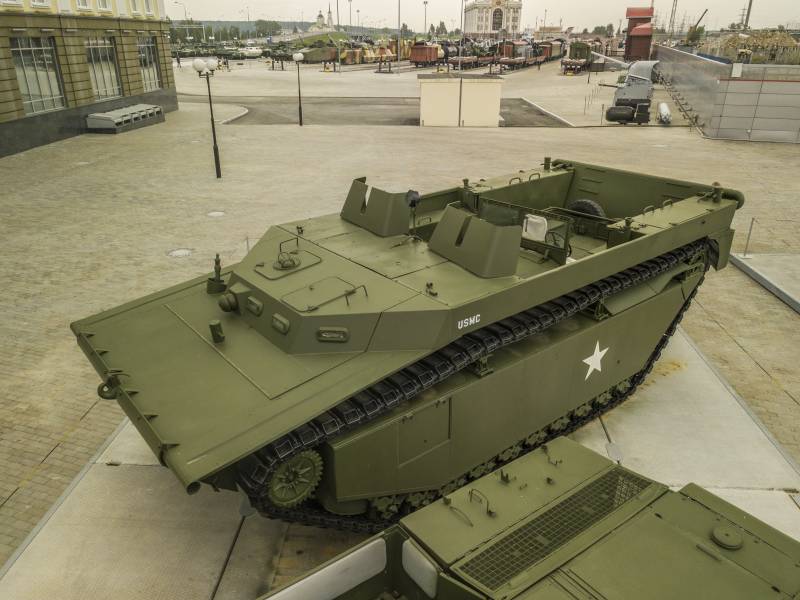
Information